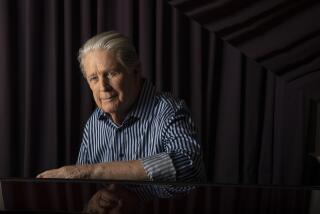Recalling Glenn Gould: An Inspired Introvert : Music: The artist in the film bears a striking resemblance to the man who left an indelible mark. But no one ever played as he did, and no one could persuasively imitate him.
- Share via
Colm Feore, a remarkably sensitive actor, gets to play a genial, eccentric, self-obsessed, self-possessed pianist in “Thirty Two Short Films About Glenn Gould.” Significantly, however, he never gets to play the piano.
That may be just as well. Some things are hard to fake. Ask Charlton Heston, who was more convincing when he parted the Red Sea in “The Ten Commandments” than when he conducted a symphony orchestra in “Counterpoint.”
The Glenn Gould who emerges in Francois Girard’s episodic quasi-biography bears a striking resemblance to the Glenn Gould who left an indelible mark on music and music-making in the 1950s and ‘60s. The film, vaguely structured in the manner of Bach’s “Goldberg” Variations--which Gould turned into something of a heroic signature piece--depicts the protagonist as a man of many faces and many quirks.
It makes canny use of his recordings on the soundtrack, and even resorts to some Wagner as background music (which Gould would have despised). The film seldom lapses, however, into the phony reverence that so often accompanies high art on the big screen, and it makes few technical mistakes (apart from insistently confusing a recital with a concert ).
Still, this fascinating portrait cannot show Glenn Gould in action. No one ever played as he did, and no one could persuasively imitate him.
Those who heard Gould, and those who continue to savor his work on CDs, know him as a thinking-person’s pianist. He was a musician who valued clarity over passion. He commanded a dazzling technique, a vast dynamic scale and a crisp sense of rhythm. He paid a lot of attention to matters of architecture, to linear propulsion and subtle detail. He all but ignored the pedal and the fuzzy generalities it induced.
Most important, perhaps, he dared take liberties. He paid little attention to tradition, to easy effect and, ultimately, to audience communication. He was the pianist who inspired a friendly collaborator, none less than Leonard Bernstein, to make a pre-performance speech disowning an unorthodox interpretation of Brahms’ D-minor Concerto.
Those who saw Gould--and, given his penchant for cancellation, that wasn’t always easy--will not forget him. I saw him for the first time in a recital at Jordan Hall in Boston. The year must have been 1955. He arrived on stage a half-hour late, confounding the skeptics who predicted he would not arrive at all. His attire looked slept in and several sizes too large. His hair gave new meaning to the concept of unruly. His gait added new dimension to the concept of gawky.
He had brought along his own slightly battered, antique Steinway. He never left home without it. He insisted on his own chair--some 14 inches low--plus cushion and carpet. A trusty glass of Poland water awaited him atop the otherwise empty music-stand.
Although the audience cheered his loping entrance, he took little notice. He slouched into his mini-seat--placed as far from the keyboard as possible--extended his extensive arms, buried his head as close as possible to his lap, closed his eyes, and started to play. Magnificently.
He also started to sing, hum, grunt, moan, roar and conduct. He stirred the air with any fingers, feet or arms that did not happen to be more directly engaged.
If another pianist had put on an act like this, the viewers would have laughed at best, scoffed at worst. Gould, however, defied scorn. An inspired introvert, he was trying to impress only himself.
Retiring from the stage must have caused him no pain. His last appearance--never announced as such--happened to take place in Los Angeles on April 10, 1964. The locale was the modest Wilshire Ebell Theatre, though you’d never recognize it in the current movie.
When Gould had excused himself from a previous engagement here in January, the management tried to mollify ticket-holders by showing a documentary. Albert Goldberg, The Times’ chief critic at the time and an authority on pianists, chose not to give this one a second chance. He sent a stringer to review the recital. Dion Winans loved the Bach and Hindemith, deplored the Beethoven and the mannerisms.
A new generation eventually got to know Gould as a writer, recording virtuoso, interviewer, composer, broadcaster, recluse and self-inventing legend. Many converts to the cause revered him primarily as the man behind the soundtrack--Bach, of course--in “Slaughterhouse Five.”
The eccentric genius was only 50 when he died in 1982. He hadn’t entered a concert hall for 18 years.
More to Read
Only good movies
Get the Indie Focus newsletter, Mark Olsen's weekly guide to the world of cinema.
You may occasionally receive promotional content from the Los Angeles Times.









